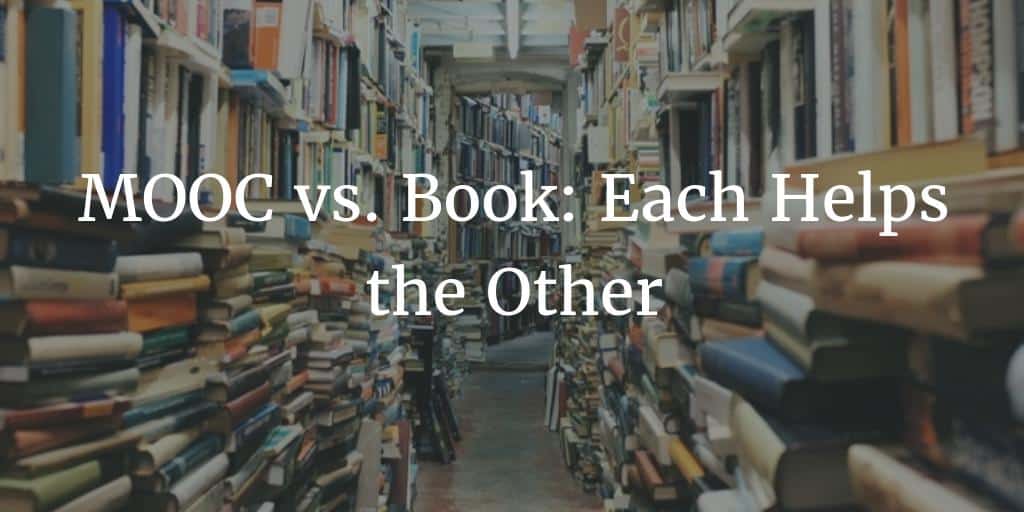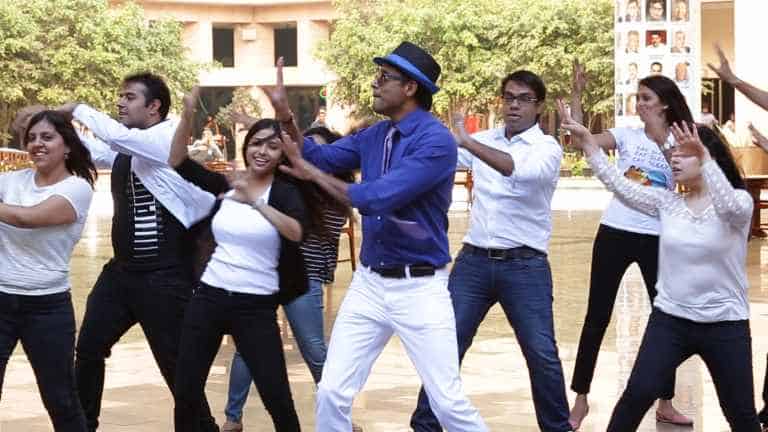MOOC vs. Book: Each Helps the Other (Part 3 of 3)
Raj Raghunathan (“Dr. Happy Smarts”) reflects on his MOOC and book, and we summarize the points that have come out of this, our three part series called “MOOC Vs. Book.”
This is part three of the series entitled MOOC vs. Book. See the first part of the series here: Which will Win: MOOC vs. Book? and part two of the series here: MOOC vs. Book: Complementary Learning Channels.
In the first post we discussed the comparison some people have made between MOOCs and digital textbooks. In part two we shared thoughts from Prof. Barbara Oakley and commented on them. Now we will share thoughts from Prof. Raj Raghunathan, a.k.a. Dr. Happy Smarts. Prof. Raghunathan created the MOOC entitled A Life of Happiness and Fulfillment, and he is the author of the book called If You’re So Smart, Why Aren’t You Happy? Below you’ll find Prof. Raghunathan’s thoughts in quotes, and some brief comments on them.
MOOC Experience Between Passive Reading and In-Person Interaction
“With e-books, learning happens mainly through reflecting on the content, whereas in MOOCs it happens to a much larger extent through discussion and exchange. The asynchronous peer-interaction and evaluation is a big plus in MOOCs because you get to hear what so many other people think of a particular issue. Of course this is not quite as good as a face-to-face class interaction, but you do gain exposure to diverse views from all corners of the world.”
We see that Prof. Raghunathan has a similar view to Prof. Oakley, in seeing MOOCs as more than a one-way conduit of information from the expert to the novice. There is the possibility of interactions among the learners, which adds a new dimension of perspectives and interest in the topic. Prof. Raghunathan also compares this to his classroom interactions, which provide even deeper interactions, but he acknowledges that the diversity benefit is not as large there as it might be in a MOOC. We see with most larger MOOCs, which typically reach over a few thousand participants, that there are participants from at least 70–80 countries.
“The main vehicle of information dissemination in the case of MOOCs is video lectures, and listening to information has a different feel than reading. Videos can be recorded over multiple takes and edited with music and graphics, conveying information in a much more efficient manner than in books or in the physical classroom.”
Like Prof. Oakley, he [Prof. Raghunathan] doesn’t see videos as simply a more convenient form of content consumption for people too lazy to read, but he sees the possibilities that thoughtfully-constructed videos can provide.
Prof. Raghunathan is discussing the main instructional vehicle in MOOCs: videos. Like Prof. Oakley, he doesn’t see videos as simply a more convenient form of content consumption for people too busy or too lazy to read, but he sees the possibilities that thoughtfully-constructed videos can provide. We already see this, of course, in plenty of educational videos and documentaries. However, when such videos are combined with discussion fora overseen by instructors and TAs, it is a powerful combination that provides a unique mix of cogent explanation, questioning, peer answers, and more authoritative responses (which may not be as good as the best peer answers). Thus, videos are a just a piece, albeit a key piece, of modern-day video-based MOOCs. (Note: the rapid and widespread adoption of broadband internet bandwidth is a big enabler of the proliferation of MOOCs, although it is not mentioned very often.)
MOOCs and Books Can Make Each Other Better
“My book was actually going to come out before the MOOC. But there were some unforeseen delays on the book, which meant that the MOOC came out first — but I am really glad it happened that way, because I got a chance to revise and refine my book based on the MOOC experience.”
“When you put together a course, it’s useful to do a lot of research, think independently, and come up with a structure and content — this flows nicely into the organization of a book. When you put together a MOOC, you are forced to think through issues like: how do I create bite-sized (6–10 minute) modules out of it? That helps you cut out the fat and get it more streamlined.”
We can see that both a book and a MOOC require deep thinking about the organization of the material. With a book, there is more room for an author to get his or her point across than there is for someone making a MOOC (data show that videos engagement drops precipitously at around the six minute mark, so it is best to slice up topics into short video clips). Thus, starting with a book and then condensing it for a MOOC creates a great deal of focus for each point that needs to be made, and in this case, it ultimately helped Prof. Raghunathan’s book. Indeed, his recently-published book is a tightly-sculpted 252 pager composed of clear writing. In addition to revisions conceived of in his own head, Prof. Raghunathan also received feedback from his MOOC students.
“I literally had hundreds volunteering to read the chapters to give me feedback. And the extent to which some of them went was just incredibly heart-warming. The comments were, overall, very positive and I got really useful feedback on both the content and the writing. There is no doubt in my mind that the course made my book better.”
It is consistent with the spirit of his approach to his topic that Prof. Raghunathan did not just sit back during his MOOC and ponder potential changes to his material, like a scientist observing a controlled experiment. After all, his subject — happiness in life — is broader than most sections in a bookstore, and he had the chance to engage with a wider audience than ever before. Not only did he interact with and listen to students during the MOOC, but when it was over Prof. Raghunathan solicited the participants for feedback on his chapters. Prof. Raghunathan acknowledged the 654 participants who gave him feedback in the “Acknowledgements” section of his book, and he mentions the MOOC prominently and early on in the book (page 5). Thus, there was a unique synergy between book and MOOC.
MOOCs and Books Fit Into The Same Ecosystem
“Because the book is coming out after the MOOC, I can’t say that the book has increased the visibility of the MOOC. But in the process of giving talks at various organizations and venues in which I give an overview of the book, I [also] get to promote the MOOC and so, in that indirect sense, the book has helped the MOOC.”
There is also some synergy in raising awareness between the book and the MOOC. As an educator deeply interested in helping people to improve their happiness levels (a stated goal in his course, book, and MOOC), we can see Prof. Raghunathan thinking about how he can promote his MOOC first of all, which has wider reach and is easier to consume, versus his book, from which he would more directly and personally benefit. This mindset helps Prof. Raghunathan to stockpile credibility, creating authenticity which has a unique power to attract in today’s noisy marketplace of ideas.
“When I launched my MOOC, many people felt that it was going to cut into the popularity of my ‘face to face’ classes both at ISB and at McCombs. If anything, it has had the opposite effect: I have had even more people seeking to enroll in my classes.”
“So, I think MOOCs, books, and physical classrooms are complementary products, rather than substitutes, and if you do one of them really well, chances are that you are going to get people to be more interested in seeing what you have to say in the other medium, rather than concluding that they have already gotten everything they want from you.”
Like Prof. Oakley, who did not fear cannibalization of her book, Prof. Raghunathan does not fear a drop-off in his class enrollment. Keep in mind, no one is required to take his face-to-face class; it is a non-core elective on the topic of happiness at an esteemed business school. His confidence in the appeal of the topic and his desire to spread the word (also note: he did have tenure) led him to double-down, and it paid off: the course, the MOOC, and his book all are thriving, and they have reinforcing effects upon each other.
Some practical advice for instructors
A Life Of Happiness and Fulfillment.
“I would definitely recommend writing a book or creating a MOOC to other teachers. It is really a great opportunity to touch the lives of so many others. However, it takes a LOT of effort. Thus, I would recommend it only under the following circumstances:
· you believe you have something unique and interesting to say;
· you are really into teaching and are passionate about it;
· you love writing in a way that reaches out to the masses, and not just the scientific community;
· you’ve had experience teaching your class for a couple of years so that you know, broadly speaking, what you want to say and how you want to say it; and
· you have sufficient time and access to resources (e.g. your host institution is supportive).“
This advice stands on its own, and I think it would be echoed by many others who have written books or created MOOCs.
This wraps up our three part series on book vs. MOOC. We have a few tentative points to summarize our thoughts, which are supported by the thoughts from Professors Oakley and Raghunathan.
- MOOCs and books serve different purposes — the former are for providing information in an engaging way, and they are also a conduit for interaction with diverse participants.
- MOOCs and books have some similarities — both require careful thought on organization and structure, with a focus on explaining things clearly.
- MOOCs and books have some differences — MOOCs have to be even more succinct than books, while books are allowed to support points in great detail, and MOOCs are able to utilize video production to increase their explanatory power.
- MOOCs and books are complementary — the audience for one does not cannibalize the audience for the other, and both require promotion to raise awareness about them. There are also benefits in organizing the material for each form.
- We should incorporate MOOCs into our educational ecosystem — there are clearly strong possibilities for MOOCs to fit a wide array of educational purposes. We should welcome new channels and new methods, and not treat these as a zero-sum game.
WINNER: Both MOOCs and books come out ahead, on account of the synergies involved.







